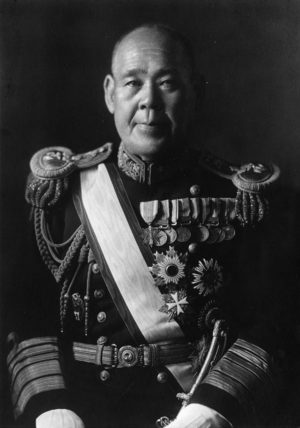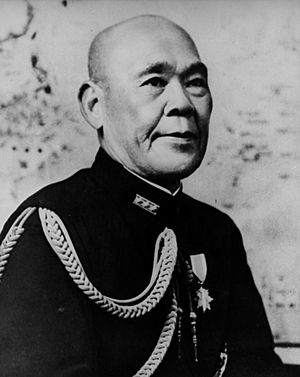Osami Nagano facts for kids
Quick facts for kids
Marshal Admiral
Osami Nagano
|
|
|---|---|
|
永野 修身
|
|

Osami Nagano, c1940
|
|
| Minister of the Imperial Japanese Navy | |
| In office 9 March 1936 – 2 February 1937 |
|
| Monarch | Shōwa |
| Prime Minister | Kōki Hirota |
| Preceded by | Ōsumi Mineo |
| Succeeded by | Yonai Mitsumasa |
| Chief of the Imperial Japanese Navy General Staff |
|
| In office 9 April 1941 – 21 February 1944 |
|
| Prime Minister |
|
| Preceded by | Prince Fushimi Hiroyasu |
| Succeeded by | Shimada Shigetarō |
| Personal details | |
| Born | June 15, 1880 Kōchi, Kōchi Prefecture, Japan |
| Died | January 5, 1947 (aged 66) Sugamo Prison, Tokyo, Occupied Japan |
| Awards |
|
| Military service | |
| Allegiance | |
| Branch/service | |
| Years of service | 1900–1947 |
| Rank | |
| Commands |
|
| Battles/wars | World War I, World War II |
Osami Nagano (永野 修身, Nagano Osami, June 15, 1880 – January 5, 1947) was a very high-ranking officer, a Marshal Admiral, in the Imperial Japanese Navy. He was one of the main military leaders of Japan during most of World War II. In April 1941, he became the Chief of the Imperial Japanese Navy General Staff, which meant he was the navy's top commander in the Asia-Pacific region. He held this powerful position until February 1944. After the war ended, he was arrested but sadly passed away in prison during his trial.
Contents
Nagano was born in Kōchi, Japan, into a family that used to be samurai (Japanese warriors). In 1900, he finished his training at the Imperial Japanese Naval Academy, coming in second out of 105 students.
After serving on ships like the cruiser Hashidate and the battleship Asahi, he became an ensign. During the Russo-Japanese War, he worked in different staff jobs. He got close to combat when he led a heavy naval gun unit during the siege of Port Arthur.
In 1905, Nagano was promoted to lieutenant. He then studied naval artillery (how to use ship guns) and navigation. From 1906 to 1908, he was the main gunnery officer on the cruiser Itsukushima. In 1909, he graduated from the Japanese Naval War College, a school for advanced naval officers.
In 1910, Nagano became a lieutenant commander and was the chief gunnery officer on the battleship Katori. From 1913 to 1915, he lived in the United States to learn English and even studied at Harvard Law School.
During World War I, Nagano was an executive officer (second-in-command) on the cruisers Nisshin and Iwate. In 1918, he was promoted to captain. The next year, he got his first and only command of a ship, the cruiser Hirado.
From December 1920, Nagano worked as a military attaché (a military diplomat) in the United States. He attended the Washington Naval Conference, where countries discussed limiting naval weapons. He returned to Japan in 1923 and was promoted to rear admiral. He visited the U.S. again in 1927 and 1933.
In 1924, Nagano became the head of the intelligence section of the Imperial Japanese Navy General Staff. He then commanded the 3rd Battleship Division and later the 1st China Expeditionary Fleet. In 1927, he was promoted to vice admiral.
From 1928 to 1929, Nagano was the leader of the Imperial Japanese Naval Academy. He brought in new teaching methods, like the Dalton Plan, which focused on students learning at their own pace.
From 1930 to 1931, he was the vice chief of the Navy General Staff. In this role, he attended the Geneva Naval Conference and the London Naval Conference 1930, which were meetings to discuss naval arms control. From 1933 to 1934, he was the commander-in-chief of the Yokosuka Naval District, a major naval base.
On March 1, 1934, he was promoted to admiral and joined the Supreme War Council, a very important group that advised the Emperor on military matters. Nagano was the main naval representative for Japan at the London Naval Conference 1935. Japan left this conference because they were not allowed to have as many warships as the United States and Great Britain.
In 1936, Nagano became the Navy Minister under Prime Minister Kōki Hirota. The next year, he became the commander-in-chief of the Combined Fleet, which was the main fighting force of the Japanese Navy. By April 1941, he had reached the highest position in the Japanese Navy, becoming the Chief of the Imperial Japanese Naval General Staff.
Role in World War II
Admiral Nagano strongly believed in Nanshin-ron, a policy that focused on Japan expanding south into Southeast Asia. He played a key role in Japan's decision to go to war with the United States. When Japanese forces took over southern Indochina in July 1941, the U.S. and its allies stopped all oil shipments to Japan. Nagano told Emperor Hirohito that Japan's oil supply would run out in two years if the embargo continued. He advised that Japan should be ready for war if talks failed.
By September 1941, he and the Army's Chief of Staff, General Hajime Sugiyama, urged Japan to prepare for war right away. They wanted all peace talks to end by mid-October.
Nagano was initially against Admiral Isoroku Yamamoto's plan to launch a surprise attack on the U.S. naval fleet at Pearl Harbor. He thought it was too risky and would distract Japan's aircraft carriers. However, he finally agreed to the attack after Yamamoto threatened to resign from his command.
In 1943, Nagano was promoted to marshal admiral, the highest rank. But by 1944, Japan was losing many battles, and Emperor Hirohito no longer trusted Nagano. With the Emperor's approval, Prime Minister Hideki Tōjō and Navy Minister Shigetarō Shimada removed Nagano from his top position. Nagano spent the rest of the war as an advisor to the government.
Images for kids
See also
 In Spanish: Osami Nagano para niños
In Spanish: Osami Nagano para niños













